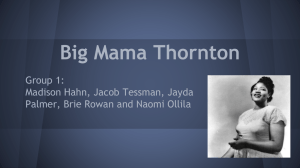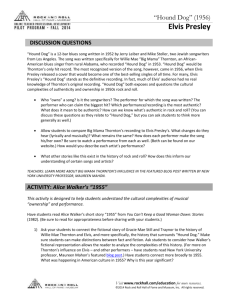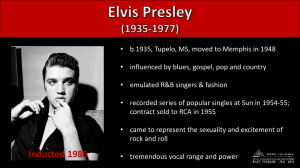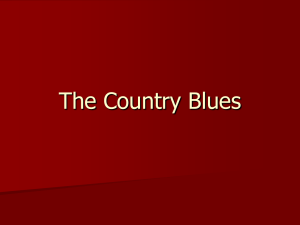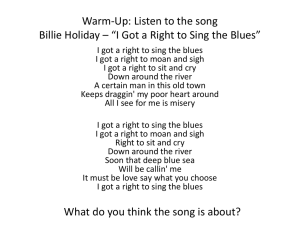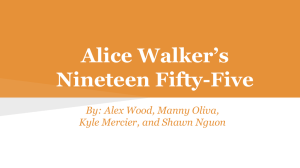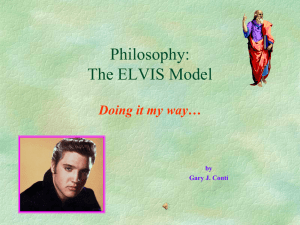Big Mama Thornton
advertisement
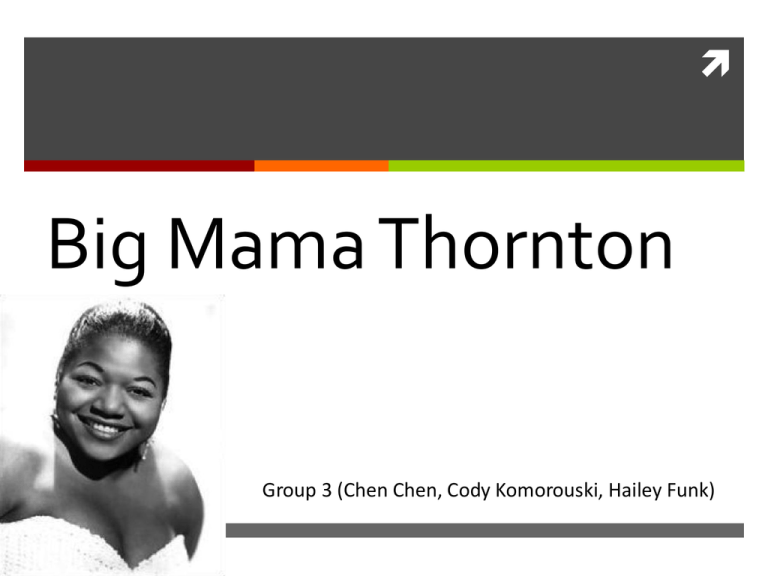
Big Mama Thornton Group 3 (Chen Chen, Cody Komorouski, Hailey Funk) Outline Biography Musical Style Musical Analysis Musical Influences Other Music of the Period(s) Comparison of Big Mama Thornton musical Style to concurrent musician Biography: Early Life Born Willie Mae Thornton (12/11/1926-07/25/1984) in Ariton, AL “Big Mama” referenced her physical size — she was a tall, heavyset woman — and the magnitude of her voice. Introduced to music by her mom as a church singer at early age. Left Montgomery in 1941, following her mom’s death. Age 15 Biography Seven-year tenure with Sammy Green’s Georgia-based hot Harlem Revue. (19411948) 1948, relocated to Houston, Texas. 1951-1957, recording contract with Peacock Records. 1957: New record label, Arhoolie relocate to San Francisco Bay Area to play at local blues clubs 1951-1970, active recording artist 07/25/1984, heart attack caused death Album Timeline Big Mama Thornton (1965) Performed at Monterey Jazz Festival (1966-1968) Stronger Than Dirt (1969) Jail (1975) San Francisco Blues Festival (1979) Ball n’ Chain (1968) American Folk Blues Festival (1965) Big Mama Thornton with the Muddy Water Blues Band (1966) Record Label: Arhoolie Mercury Vanguard Mama’s Pride (1978) Big Mama Thornton Musical Style • First release in 1952 • General Style: • • • • • • Tempo: 140 beats per minute, 4 beats per bar Form: 12- bar blues Features: Thornton uses a rough, classic blues-style tone quality Rhythm section – country blues-style guitar rhythms, bass on beats, and hand clapping with a drum stuck on the side for a strong backbeat Fills by guitar bending strings to produce blue notes Lyrics: love songs Musical Analysis • Tempo: fast 140 beats per minute, 4 beats per bar • Form: 12- bar blues • Quadruple meter, duple subdivision. Contain backbeat • It has a medium range, more disjunct and varied melody. • It’s homophonic with melody and accompaniment • Lyrics is love-oriented. Music analysis--Instrumentation Main instruments used: guitar, piano, bass and drums can be heard Piano and guitar feature most importantly Occasional saxophone sound Rhythm is not the usual “offbeat” rock sound Instruments take backseat to her powerful voice Musical Influence—under earlier influence Under the influence of her mother, a church singer. High gospel sound influence Self taught musician: Learned to sing, play harmonica, and drums Can’t read music: a lot of improvisatio. Distinctive sound: thrilled audiences, inspired others Musical Influence on Other Artists Presley and Joplin borrowed elements of her vocal sound and style of delivery — as well as key parts of her repertoire – as they developed their own creative voices. Presley’s version of “Hound Dog” incorporated elements of Thornton’s style: The snarl in her voice and the ways she snaps off the words in the song’s opening, for example. His faster tempo eradicates some of the confident defiance of Thornton’s original, but he imports her “swagger” and forceful vocals “hollering it out” in a deep, husky voice. Presley plays on sexuality, much like Thornton. Musical Influence on Other Artists Thornton became known to the young white blues revivalists and helped to shape the sound of the next phase of rock and roll, most notably through her connection to Joplin who recorded Thornton’s composition “Ball ‘n’ Chain.” Rock critic Robert Christgau described Joplin’s vocal style as “two-thirds Willie Mae Thornton and one-third Kitty Wells,” partly grew out of singing against the volume produced by her band. Musical Influence-popularity Mainly R&B popular Participated in many blues festivals “Hound Dog” was R&B #1 Never made pop charts Elvis’s cover did Was paid only $500 total for her song 1984: inducted to Blues Hall of Fame Other Music of the Period(s) • Bill Haley (1925-1981) • Elvis Presley (1935-1977) • Carl Perkins (1932-1998) • Jerry Lee Lewis (1935-now) • Eddie Cochran (1938-1960) • Gene Vincent (1935-1971) • The Everly Brothers • Buddy Holly (1938-1959) • Fats Domino (born in 1929) Thornton’s Hound dog Recorded at Radio Recorders in Los Angeles on August 13, 1952. Some of the choruses have thirteen rather than twelve bars, and had the band bark and howl like hound dogs at the end of the song. Her vocals include lines such as: "Aw, listen to that ole hound dog howl...OOOOoooow," "Now wag your tail," and "Aw, get it, get it, get it.” Has flexible phrasing making use of micro-inflections and syncopations. Over a steady backbeat, she starts out singing each line as one long upbeat Elvis’s Hound dog Elvis would later call "the most embarrassing moment" of his career; he appeared, singing "Hound Dog" to a Bassett hound while wearing his white tie and tails. No hip-wiggling, no gyrations, Elvis was directed to just stand there and sing the song to the bored-looking mutt named Sherlock. Elvis dutifully did what he was told and the whole "Hound Dog" thing might have just ended like the memory of a bad toothache for a disillusioned Elvis. It took the super-sensitive Elvis 31 takes to get just the right version of "Hound Dog" on acetate. He stayed with 12 bar blue. Social Influence Black culture: racial segregation was the norm had its own distinct characteristics (speech, dance, religion, dress, & music) Gospel and Rhythm & Blues "race" records Comparison to Current Musicians • Similarities: • Fast tempo • 12- bar blues form (4 beats per bar), • Love-oriented lyrics • Under the influence of Gospel and Rhythm & Blues • Unique features: • Female singer with a rough tone quality • No saxophone solos or pounding pianos that marked the R&B sound. • Supported by guitar, bass and drums (vocals dominate) • Confident attitude • blues tradition of outspoken women in R&B • set the style for rock and roll: putting sexuality/gender expectations in foreground. Reference Dreisbach, Tina. "Willie Mae "Big Mama" Thornton." Encyclopedia of Alabama. 5 Apr. 2011. Web. 25 June 2013. Mahon, Maureen. "Mama's Voice." Mama's Voice. Duke University Press, n.d. Web. 23 June 2013. Stuessy, Joe, and Scott Lipscomb. Rock and Roll: It's History and Stylistic Developments. 7th ed. N.p.: Pearson, 2013. Print.
